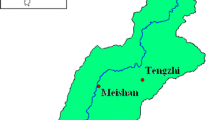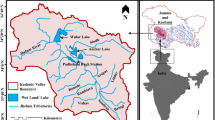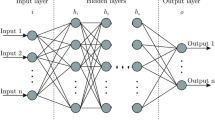Abstract
In typhoon-prone areas, in order to announce catastrophe warnings in advance accurate storm-intensity prediction is essential. In this study, forecasting typhoon intensity with their characteristics has been supported by two different artificial intelligence methods, a simple artificial neural network (ANN) and an adaptive neuro-fuzzy inference system (ANFIS) based on genetic algorithm (GA). The data used throughout this paper are from the reanalysis data set of the National Centers for Environmental Prediction and the best track database of the National Oceanic and Atmospheric Administration. The typhoons selected for this study happened during 1985–2008 over the South China Sea. By comparing the results from these two methods, their advantages and disadvantages were investigated. The results of the study confirm the superiority of the ANFIS-GA method, because its root mean square error was 3.78, which is significantly lower than the value of 6.11 for the ANN method in the best experiments. Considering the literature in typhoon intensity prediction by ANN and ANFIS models, the contribution of this paper is to investigate whether or not these methods are able to forecast typhoon intensity. The study represents that the ANFIS model can produce more applicable predictions for typhoon intensity than the ANN model.






Similar content being viewed by others
References
Ali M, Kishtawal C, Jain S (2007) Predicting cyclone tracks in the north Indian Ocean: an artificial neural network approach. Geophys Res Lett 34(4):L04603
Banik S, Chanchary FH, Khan K, Rouf RA, Anwer M (2008) Neural network and genetic algorithm approaches for forecasting bangladeshi monsoon rainfall. In: Computer and Information Technology. ICCIT 2008. 11th International Conference on, 2008. IEEE, pp 735–740
Bao J, Michelson S, Wilczak J (2002) Sensitivity of numerical simulations to parameterizations of roughness for surface heat fluxes at high winds over the sea. Mon Weather Rev 130(7):1926–1932
Chang LC, Chang FJ (2001) Intelligent control for modelling of real-time reservoir operation. Hydrolo Proc 15(9):1621–1634
Chau K, Wu C, Li Y (2005) Comparison of several flood forecasting models in Yangtze River. J Hydrolo Eng 10(6):485–491
Chaudhuri S, Middey A (2011) Adaptive neuro-fuzzy inference system to forecast peak gust speed during thunderstorms. Meteor Atmos Phys 114(3):139–149
EIA (2012) South China Sea [Online]. Available: http://www.eia.gov/countries/regions-topics.cfm?fips=SCS. Accessed 1 May 2012
Gao Y, Wu T, Chen B, Wang J, Liu Y (2013) A numerical simulation of microphysical structure of cloud associated with the 2008 winter freezing rain over Southern China. J Meteorolo Soc-JPN 91(2):101–117
Haghroosta T, Ismail WR (2013) Influence of noul typhoon on Sea surface temperature, heat fluxes and precipitation rate. Int J Scient Res Publ 3(6):1–14
Jacovides C, Kontoyiannis H (1995) Statistical procedures for the evaluation of evapotranspiration computing models. Agr Water Mgmt 27(3):365–371
Jang JSR (1993) ANFIS: adaptive-network-based fuzzy inference system. Syst Man Cybern IEEE Trans 23(3):665–685
Jang JSR, Sun CT (1995) Neuro-fuzzy modeling and control. Proc IEEE 83(3):378–406
Jang JR, Sun C, Mizutani E (1997) Neuro-fuzzy and soft computing. PTR Prentice Hall, New Jersey
Jeong C, Shin JY, Kim T, Heo JH (2012) Monthly precipitation forecasting with a neuro-fuzzy model. Water Resour Mgmt 26(15):4467–4483
Jin L, Yao C, Huang X (2006) An improved method on meteorological prediction modeling using genetic algorithm and artificial neural network. In: The Sixth World Congress on Intelligent Control and Automation (WCICA), 2006, Dalian, China. IEEE, pp 31–35
Kalnay E, Kanamitsu M, Kistler R, Collins W, Deaven D, Gandin L, Iredell M, Saha S, White G, Woollen J (1996) The NCEP/NCAR 40-year reanalysis project. Bull Am Met Soc 77(3):437–471
Knapp KR, Kruk MC, Levinson DH, Diamond HJ, Neumann CJ (2010) The international best track archive for climate stewardship (IBTrACS) unifying tropical cyclone data. Bull Am Met Soc 91(3):363–376
Lin GF, Chen LH (2005) Application of an artificial neural network to typhoon rainfall forecasting. Hydrolo Proc 19(9):1825–1837
Liu M (2006) Discrete-time delayed standard neural network model and its application. Sci China Ser F-Earth Sci 49(2):137–154
Ma J, Hasi B (2005) Remote sensing data classification using tolerant rough set and neural networks. Sci China Ser D-Earth Sci 48(12):2251–2259
Majumdar KK (2002) A Fuzzy dynamical system modelling of a disturbance leading to cyclogenesis. J Intel Fuzzy Syst 13(1):7–15
McCulloch WS, Pitts W (1943) A logical calculus of the ideas immanent in nervous activity. Bull Math Biophys 5(4):115–133
More A, Deo M (2003) Forecasting wind with neural networks. Mar Struct 16(1):35–49
Pallavi VP, Vaithiyanathan V (2013) Combined artificial neural network and genetic algorithm for cloud classification. Int J Eng Tech 5(2):787–794
Pan J, Yan X-H, Jo Y-H, Zheng Q, Liu WT (2004) A new method for estimation of the sensible heat flux under unstable conditions using satellite vector winds. J Phys Oceanogr 34(4):968–977
Rumelhart DE, Widrow B, Lehr MA (1994) The basic ideas in neural networks. Commun ACM 37(3):87–92
Sivanandam M (2009) Introduction to artificial neural networks. Vikas Publishing House Pvt Ltd, India
Smith M (1993) Neural networks for statistical modeling. John Wiley & Sons Inc, New York
Sudheer K, Gosain A, Ramasastri K (2002) A data-driven algorithm for constructing artificial neural network rainfall-runoff models. Hydrolo Proc 16(6):1325–1330
Sugeno M, Kang G (1988) Structure identification of fuzzy model. Fuzzy Sets Syst 28(1):15–33
Tseng CM, Jan CD, Wang JS, Wang C (2007) Application of artificial neural networks in typhoon surge forecasting. Ocean Eng 34(11):1757–1768
Wang Y, Zhang W, Fu W (2011) Back Propogation (BP)-neural network for tropical cyclone track forecast. In: 19th International Conference on Geoinformatics, Shanghai, China. IEEE, pp 1–4
Wong C, Venneker R, Uhlenbrook S, Jamil A, Zhou Y (2009) Variability of rainfall in Peninsular Malaysia. Hydrol Earth Syst Sci Discuss 6:5471–5503
Yao C, Jin L, Huang M, Huang X (2007) An experiment with methods of forecasting tropical cyclones intensity base on combination of the genetic algorithm and artificial neural network. Acta Oceanolo Sinica 04:456–457
Yip C, Wong K (2004) Efficient and effective tropical cyclone eye fix using genetic algorithms. Knowl Based Intel Inf Eng Syst 3213:654–660
Zhang GJ, McPhaden MJ (1995) The relationship between sea surface temperature and latent heat flux in the equatorial Pacific. J Climate 8(3):589–605
Zhou X, Chen JC (2006) Ensemble forecasting of tropical cyclone motion using a baroclinic model. Adv Atmos Sci 23(3):342–354
Zurada JM (1992) Introduction to artificial neural systems, vol 4. PWS Publishing C, Boston
Acknowledgments
This study is supported by a fellowship from Center for Marine and Coastal Studies (CEMACS), Universiti Sains Malaysia.
Author information
Authors and Affiliations
Corresponding author
Rights and permissions
About this article
Cite this article
Haghroosta, T., Ismail, W.R. Comparing typhoon intensity prediction with two different artificial intelligence models. Evolving Systems 6, 177–185 (2015). https://doi.org/10.1007/s12530-014-9106-0
Received:
Accepted:
Published:
Issue Date:
DOI: https://doi.org/10.1007/s12530-014-9106-0




